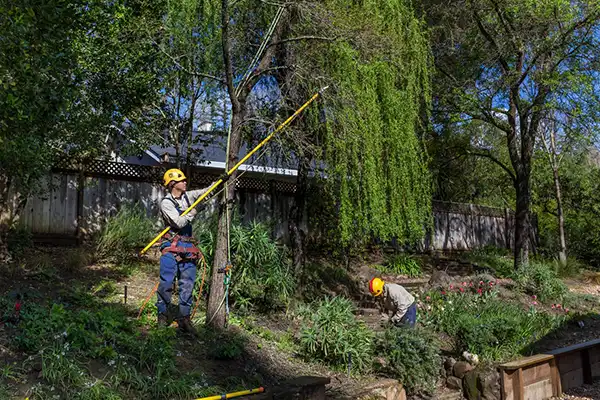Tree trimming is often seen as a straightforward solution for controlling height, but one common practice—over-topping—can have detrimental effects on the health of your trees.
This method not only deprives lower branches of essential sunlight, resulting in sparse foliage and stunted growth, but it also compromises the overall vitality of the tree, making it more susceptible to various vulnerabilities.
Instead of resorting to over-topping, consider exploring more sustainable alternatives that could promote the longevity and well-being of your trees.
The Negative Impact of Over-Topping on Tree Health
Tree topping, also known as heading, is a harmful and outdated practice that should be avoided at all costs.
It involves the indiscriminate cutting back of large branches to stubs or lateral branches that are not large enough to sustain the remaining branch.
Severe Stress and Weakening:
- Reduced Photosynthesis: Topping severely reduces the tree’s leaf area, significantly impacting its ability to photosynthesize and produce the energy it needs to survive.
- Stunted Growth: The tree’s growth is severely stunted, and it may never fully recover from the shock of topping.
- Increased Vulnerability: Topped trees are more susceptible to diseases, pests, decay, and storm damage due to their weakened condition.
Structural Instability:
- Weak Branch Growth: Topping stimulates the growth of numerous weak, upright shoots (“water sprouts”) below each cut. These shoots are prone to breakage, especially during storms or high winds.
- Increased Risk of Failure: The weakened structure of a topped tree significantly increases the risk of branch failure, which can pose a serious safety hazard.
Aesthetically Unpleasing:
- Distorted Appearance: Topped trees have a severely distorted and unnatural appearance, detracting from the beauty of the landscape.
- Reduced Property Value: The unsightly appearance of a topped tree can negatively impact the curb appeal and property value of your home.
Environmental Impact:
- Reduced Carbon Sequestration: Topped trees are less effective at absorbing carbon dioxide from the atmosphere, contributing to climate change.
Alternatives to Topping:
- Crown Reduction: This technique involves reducing the size of the tree’s crown by selectively removing branches to a lateral branch or bud.
- Thinning: Thinning involves removing some branches within the crown to improve air circulation and light penetration.
- Raising the Crown: Raising the crown involves removing lower branches to increase clearance for pedestrians, vehicles, or buildings.
By avoiding tree topping and opting for proper pruning techniques, you can ensure the long-term health, safety, and aesthetic appeal of your trees.
Increased Risks of Pests and Diseases
Tree topping severely compromises a tree’s health and defense mechanisms, making it highly vulnerable to pests and diseases.
Weakened Tree Defense Mechanisms:
- Reduced Photosynthesis: Topping significantly reduces the tree’s leaf surface area, drastically impacting its ability to photosynthesize and produce the energy necessary for growth and defense.
- Compromised Energy Reserves: The reduced energy production weakens the tree’s overall health and its ability to defend itself against pests and diseases.
Increased Entry Points for Pathogens:
- Large Wounds: The large, open wounds created by topping provide easy entry points for various pathogens, including fungi, bacteria, and viruses.
- Decay and Rot: These wounds can lead to decay and rot within the tree, further weakening its structure and increasing its susceptibility to disease.
Attraction of Pests:
- Distressed Tree Signals: The stress caused by topping can attract various pests, such as borers, bark beetles, and woodpeckers, that are drawn to weakened trees.
- Increased Vulnerability: Topped trees are more susceptible to infestations from a variety of pests, including aphids, scale insects, and leaf-eating insects.
Disease Susceptibility:
- Fungal Infections: Topped trees are highly susceptible to fungal infections, such as cankers, which can weaken and kill branches and even the entire tree.
- Dutch Elm Disease: In the case of elm trees, topping can significantly increase their susceptibility to Dutch elm disease, a devastating fungal disease.
By avoiding tree topping and opting for proper pruning techniques, you can significantly reduce the risk of pest and disease infestations, ensuring the long-term health and vitality of your trees.
Sustainable Alternatives to Over-Topping
Topping trees is a harmful practice that can severely damage their health and longevity.
Fortunately, there are several sustainable alternatives that can achieve desired results while preserving the tree’s natural form and function.
Crown Reduction:
- Purpose: Reduces the overall size of the tree’s crown by selectively removing branches back to lateral branches.
- Benefits: Maintains the tree’s natural shape and structure while controlling its size.
Thinning:
- Purpose: Removes some branches within the crown to improve air circulation, light penetration, and overall tree health.
- Benefits: Reduces the density of the canopy, allowing more light to reach lower branches and preventing excessive shading.
Raising the Crown:
- Purpose: Removes lower branches to increase clearance for pedestrians, vehicles, or buildings.
- Benefits: Creates more usable space beneath the tree while maintaining the overall height and shape.
Selective Pruning:
- Purpose: Removes specific branches that are dead, dying, diseased, crossing, or rubbing.
- Benefits: Improves tree health, reduces the risk of structural failure, and enhances the overall appearance.
Consulting with a Certified Arborist:
- Expert Advice: Consulting with a certified arborist is crucial for determining the most appropriate pruning techniques for your specific trees and landscape.
- Personalized Recommendations: Arborists can assess the health and structure of your trees and provide personalized recommendations for pruning and maintenance.
By choosing sustainable alternatives to topping and consulting with qualified professionals, you can ensure the health, safety, and aesthetic appeal of your trees for years to come.
While tree trimming may seem like a simple task, the practice of over-topping can have severe and long-lasting consequences for tree health.
By understanding the detrimental effects of topping, such as reduced photosynthesis, increased vulnerability to pests and diseases, and structural instability, you can make informed decisions about tree care.
Choosing sustainable alternatives like crown reduction, thinning, and raising the crown, and consulting with a certified arborist, will ensure the long-term health, safety, and aesthetic appeal of your trees, preserving their beauty and ecological value for generations to come.

